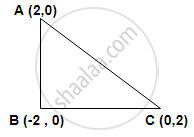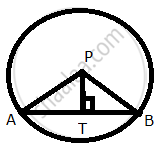Advertisements
Advertisements
प्रश्न
Show that the points (2, 0), (–2, 0), and (0, 2) are the vertices of a triangle. Also, a state with the reason for the type of triangle.
उत्तर
A ≡ (2, 0) ≡ (x1, y1)
B ≡ (–2 , 0) ≡ (x2, y2)
C ≡ (0, 2) ≡ (x3, y3)

∴ ABC form a triangle.
AB = `sqrt ((x_2 - x_1)^2 + ("y"_2 - "y"_1)^2)`
= `sqrt ((-2-2)^2 + (0 - 0)^2)`
= `sqrt ((-4)^2 + 0)`
= `sqrt(16)`
= 4 units
AC = `sqrt ((x_3 - x_1)^2 + ("y"_3 - "y"_1)^2)`
= `sqrt ((0-2)^2 + (2 - 0)^2)`
= `sqrt ((-2)^2 + (2)^2)`
= `sqrt (4 + 4)`
= `sqrt(8)`
= `2sqrt(2)` units
BC = `sqrt ((x_3 - x_2)^2 + ("y"_3 - "y"_2)^2)`
= `sqrt ((0-(-2)^2) + (2 - 0)^2)`
= `sqrt ((0 + 2)^2 + (2 - 0)^2)`
= `sqrt ((2)^2 + (2)^2)`
= `sqrt(8)`
= `2sqrt(2)` units
So, if side AC and side BC are equal then the triangle is an isosceles triangle.
AB2 = BC2 + AC2
`(4)^2 = (2sqrt2)^2 + (2sqrt(2))^2`
16 = 8 + 8
16 = 16
So, it is a right-angle isosceles triangle.
APPEARS IN
संबंधित प्रश्न
The x-coordinate of a point P is twice its y-coordinate. If P is equidistant from Q(2, –5) and R(–3, 6), find the coordinates of P.
Find the distance between the following pairs of points:
(a, b), (−a, −b)
Name the type of quadrilateral formed, if any, by the following points, and give reasons for your answer:
(- 1, - 2), (1, 0), (- 1, 2), (- 3, 0)
Find the distance between the points
A(-6,-4) and B(9,-12)
Using the distance formula, show that the given points are collinear:
(-2, 5), (0,1) and (2, -3)
If P (x , y ) is equidistant from the points A (7,1) and B (3,5) find the relation between x and y
Show that the points A(1, 2), B(1, 6), C(1 + 2`sqrt3`, 4) are vertices of an equilateral triangle.
Find the distances between the following point.
A(a, 0), B(0, a)
Find the distance between the following pair of point in the coordinate plane.
(1 , 3) and (3 , 9)
Find the distance between the following pairs of point in the coordinate plane :
(13 , 7) and (4 , -5)
Find the distance between P and Q if P lies on the y - axis and has an ordinate 5 while Q lies on the x - axis and has an abscissa 12 .
Prove that the points (1 ,1),(-4 , 4) and (4 , 6) are the certices of an isosceles triangle.
Prove that the points (0 , -4) , (6 , 2) , (3 , 5) and (-3 , -1) are the vertices of a rectangle.
Prove that the points P (0, -4), Q (6, 2), R (3, 5) and S (-3, -1) are the vertices of a rectangle PQRS.
Point P (2, -7) is the centre of a circle with radius 13 unit, PT is perpendicular to chord AB and T = (-2, -4); calculate the length of AB.

The point which lies on the perpendicular bisector of the line segment joining the points A(–2, –5) and B(2, 5) is ______.
If the distance between the points (4, P) and (1, 0) is 5, then the value of p is ______.
Find the points on the x-axis which are at a distance of `2sqrt(5)` from the point (7, – 4). How many such points are there?
Find a point which is equidistant from the points A(–5, 4) and B(–1, 6)? How many such points are there?
The centre of a circle is (2a, a – 7). Find the values of a if the circle passes through the point (11, – 9) and has diameter `10sqrt(2)` units.
